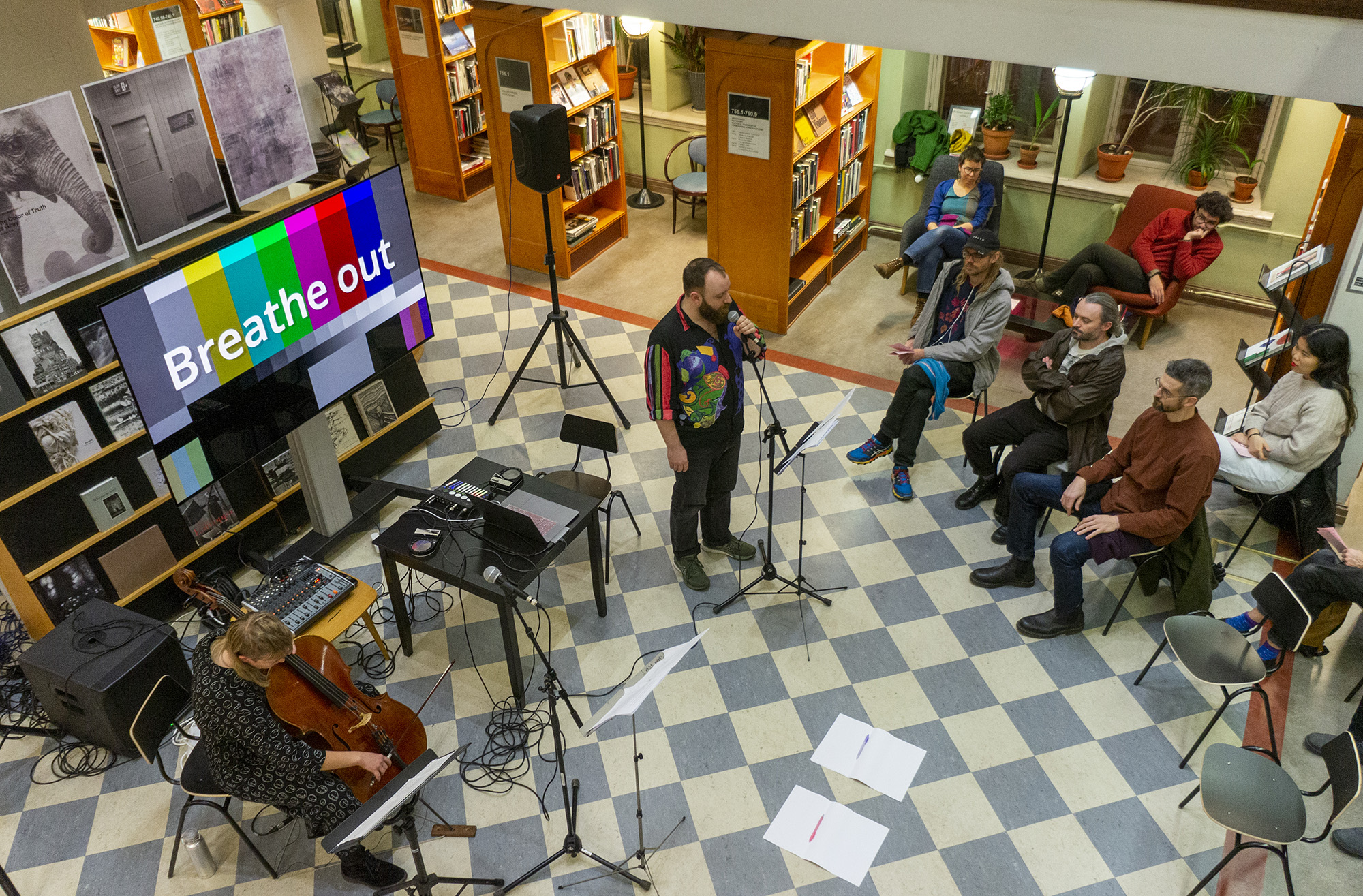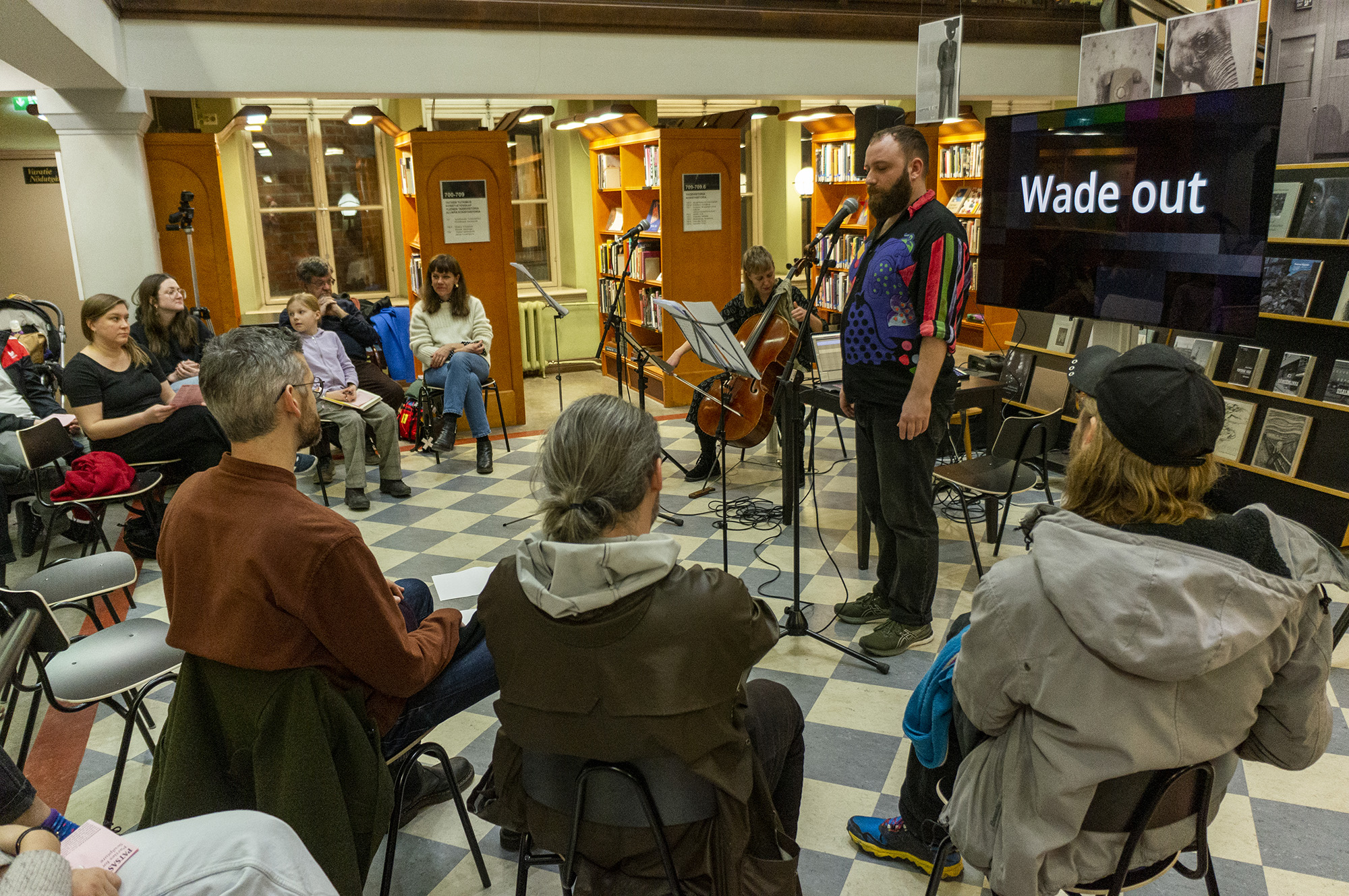14
WADER
James BlackDATE: Thursday 17.11.22, 18:30
SCULPTURE: Kahlaaja / Wader by Wäinö Aaltonen, Rikhardinkatu Library






Copenhagen based composer and
musician James Black will perform a new piece in Rikhardinkatu Library leading off from the Wader sculpture by Wäinö Aaltonen (situated at the top of the library)
Equal parts cabaret, noise music, performance art, electronica, and contemporary classical, James Black’s music has been variously described as muscular, sad, painful, personal, crazy, and deeply honest. Black’s works have drawn a large amount of attention for their signature combination of fearlessness, vulnerability, artistic courage, and sensitivity, and are often multi-disciplinary, combining score music, electronics, video, visual art, theatrical elements, and writing. Their first album, Music is not always participatory, released on Da Capo Records in 2021, presented a ‘techno-pagan trash-folk, that treats all its sources with respect’ – the sources being an intense and unique blend of computer game music, British folk song, Catholic hymns, Schubert, and electronic drum machines. The result is a singular clash of trash and spirituality that ‘flirts with failure, but delivers powerfully on the fundamentals of art and expression.’
Image: Malin Annie Jansson
The event is supported by the Nordic Culture Fund.
#patsastellaan #partiesforpublicsculpture #nordiskkulturfond
James Black was born in Torquay, UK in 1990, and grew up in Bristol. They studied musicology and composition at the University of Oxford before moving to Denmark in 2013 to complete their studies at the Royal Danish Academy of Music. They have won various prizes and awards, including the Pelle prize, the Carl Nielsen foundation talent award, and the Danish Arts Council’s large working grant. In July 2022, Black’s collective INU4 staged the first edition of the Danish New Music Academy - a summer academy for composers and performers - and in August 2022, Black was appointed artistic director of Klang festival.
https://www.jamesblackcomposer.com/
https://www.jamesblackcomposer.com/
Wader by Wäinö Aaltonen, marble, 1922
Wader is a small white marble statue made by Wäinö Aaltonen in Rome in 1922. It was bought and donated to the city of Helsinki by the art dealer Göstä Stenman in 1924. Wader was placed in a pool in the Tähtitorninmäki park in 1925 but the work suffered from vandalism and was removed for conservation work. In 1994 it was placed on the top floor of Rikhardinkatu library.
Wader shows the upper part of a female with the lower part assumed to be under water. It is associated with Akseli Gallen-Kallela's depictions of Kalevala's Aino. Aaltonen depicts the fleeing maiden's movement in the water similarly to Gallen-Kallela, with the upper body twisting to one side and the head turned as if the girl is trying to shield herself from someone's gaze. Aaltonen made several female figures in the 1920s, giving them names such as "Wader", "Bathing", etc. His aim was to present an ideal Finnish woman but his proposals provoked heated debate. The works were criticized for what was considered excessive stockiness. Aaltonen's reply was that this was inevitable due to the demands of the stone he used; the figures were founded on a surface created by light and shadow where the shadows gradually become lighter and, correspondingly, the light darkens into shadow. Aaltonen's expression does not seek naturalism but is a living shape created by the artist.
The work of art belongs to the collection of HAM Helsinki Art Museum.
The sculpture is located in Rikhardinkatu Library, Helsinki
Wader is a small white marble statue made by Wäinö Aaltonen in Rome in 1922. It was bought and donated to the city of Helsinki by the art dealer Göstä Stenman in 1924. Wader was placed in a pool in the Tähtitorninmäki park in 1925 but the work suffered from vandalism and was removed for conservation work. In 1994 it was placed on the top floor of Rikhardinkatu library.
Wader shows the upper part of a female with the lower part assumed to be under water. It is associated with Akseli Gallen-Kallela's depictions of Kalevala's Aino. Aaltonen depicts the fleeing maiden's movement in the water similarly to Gallen-Kallela, with the upper body twisting to one side and the head turned as if the girl is trying to shield herself from someone's gaze. Aaltonen made several female figures in the 1920s, giving them names such as "Wader", "Bathing", etc. His aim was to present an ideal Finnish woman but his proposals provoked heated debate. The works were criticized for what was considered excessive stockiness. Aaltonen's reply was that this was inevitable due to the demands of the stone he used; the figures were founded on a surface created by light and shadow where the shadows gradually become lighter and, correspondingly, the light darkens into shadow. Aaltonen's expression does not seek naturalism but is a living shape created by the artist.
The work of art belongs to the collection of HAM Helsinki Art Museum.
The sculpture is located in Rikhardinkatu Library, Helsinki


